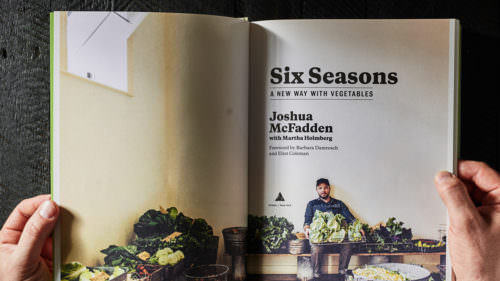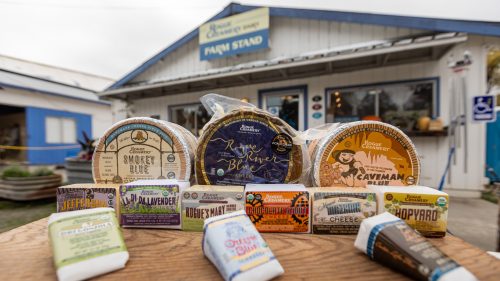Food brings people together, no matter whether we’re dining at the same restaurant, sitting around the kitchen table or obsessing over pretty dishes on Instagram. While restaurants are temporarily closed for in-person dining, Oregon’s chefs have been keeping busy. Across the board, Oregon’s restaurateurs are home with their loved ones, cooking and eating, and staying nourished as best they can. Here are three of their comforting recipes and stories for fresh inspiration while you’re sheltering in place.

Pan-Seared Halibut Cheeks:
Lyf Gildersleeve,
Flying Fish Company
Lyf Gildersleeve opened Flying Fish Company on East Burnside in Portland on Feb. 10, a project nine years in the making. Five weeks later, Gov. Kate Brown issued the executive order to temporarily close restaurants and other nonessential businesses to prevent the spread of COVID-19, sending owners into crisis mode. “We’re scrambling — what are we going to do to survive?” says Gildersleeve, echoing the thoughts of most in the industry.
The answer for many has been to pivot to takeout only for now, which Flying Fish was well positioned to do. The retail fish market sells everything from wild Oregon Coast salmon and halibut to lingcod, bay shrimp, oysters and razor clams, with shipping available nationwide. The restaurant also makes prepared takeout foods such as homemade curry sauces, chowder, poke and fresh fish sandwiches. His products are just days out of the water and sustainably sourced. And often his prices are lower, since he works directly with the fishermen to eliminate the middleman.
Gildersleeve — who started out in 2010 by running a food cart, then a fish shack, then working with some of Portland’s top chefs — has been staying busy while sheltering in place. He’s home with his wife and two young children, dog, parakeet, two chickens and two hives of honeybees on his quarter-acre of land just outside Portland. He’s also using the time to tinker in his permaculture-based backyard, where he has a dozen fruit trees and an aquaponics setup he built from his college studies in aquaculture — a science that combines fish farming and growing vegetables without soil.
Gildersleeve’s recipe for pan-seared halibut cheeks is something he loves to make at home with his family — a unique and simple way to use what he considers the best part of the halibut, the part fishermen keep for themselves. The halibut cheek (which Flying Fish stocks in the freezer) has a sweet, delicate texture that tastes like something between scallop and crab. Oregon’s halibut season is in June, with fresh fish coming off the boats in Garibaldi. The recipe is so simple, it’s best to season by taste.
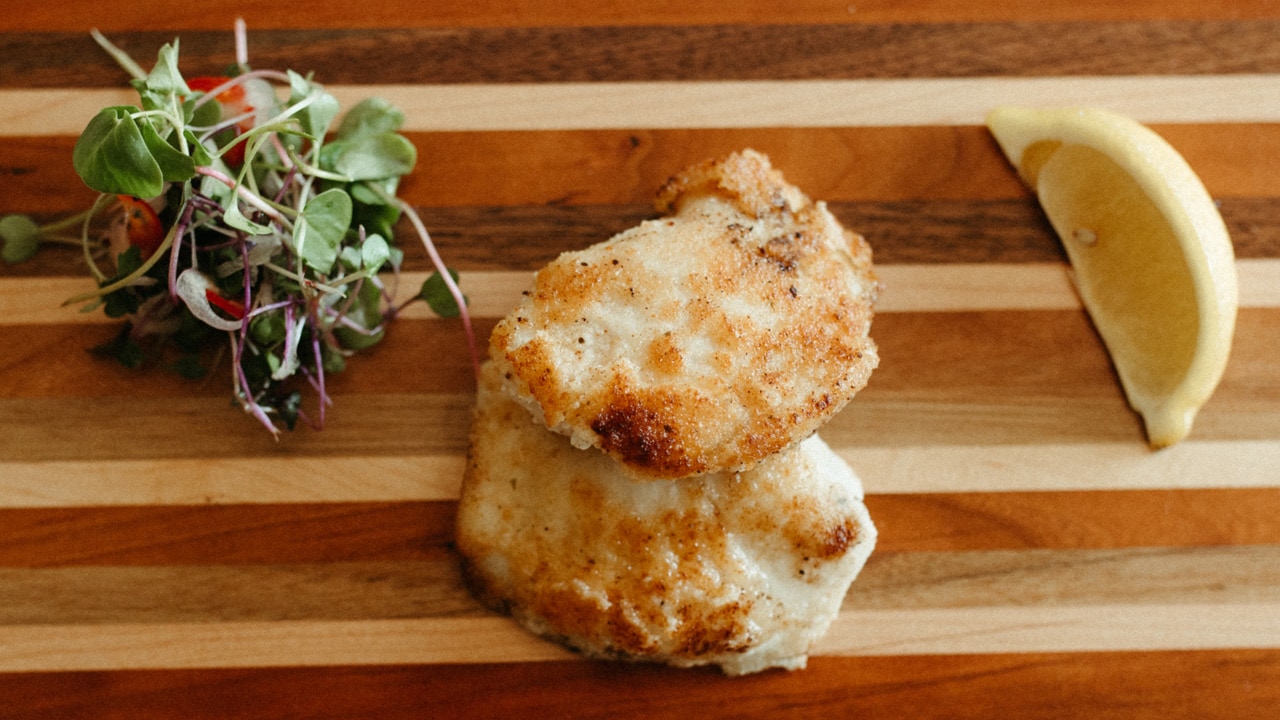
Pan-Seared Halibut Cheeks
- Halibut cheeks, sourced fresh
- Grapeseed oil or other high-heat oil such as avocado or coconut
- All-purpose or gluten-free flour
- Salt, pepper, Old Bay seasoning (to taste)
- 1 tsp. butter
- Squeeze of lemon
- Finishing salt
Rinse halibut cheeks under cold water and pat dry with a paper towel. Lightly coat fish with oil and dust lightly with seasoned-flour mixture to taste. Heat cast-iron pan to medium-high heat, add a tablespoon of butter and immediately place cheeks in the smoking-hot pan. Let cook for 1 minute each side (depending on the thickness of cheek), only until a fork will separate the meat. Take out before it’s completely done because fish will keep cooking after you take it off the heat. Take caution not to overcook the fish. Remove from heat and place on a paper towel to absorb excess oil. Use finishing salt and a squeeze of lemon. Serve immediately with your favorite side dishes and Oregon craft beer or wine.
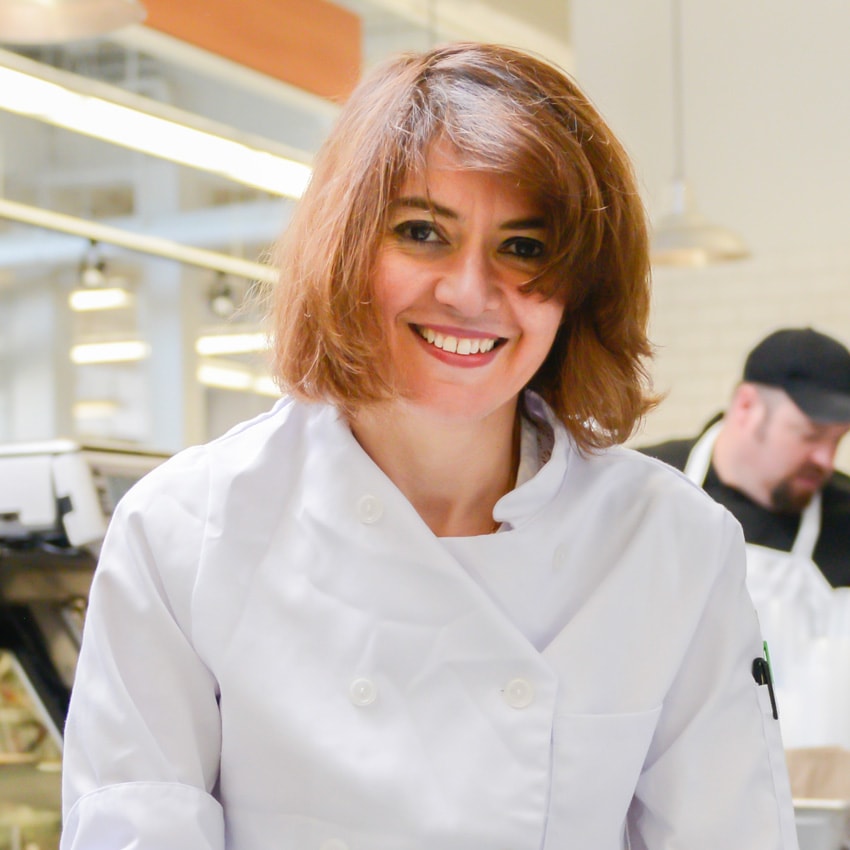
Lebanese Lamb Stew:
Mirna Attar,
Ya Hala
Mirna Attar has been serving up Lebanese comfort food for 20 years now, so she has just the right homestyle recipe to offer for these times: a Lebanese lamb stew. “The aroma of vegetables, spices and lamb are so good together,” says Attar, chef/owner of Ya Hala restaurant in outer Southeast Portland, as well as two locations of her internationally focused grocery store, World Foods Portland.
Home cooks may substitute beef — a good beef chuck roast — or another protein, or go for a vegetarian version. It calls for spices like cumin, cinnamon and coriander that are warm and soul soothing, meant to be enjoyed with loved ones — preferably with a great bottle of wine. She recommends the Monument Permanent Piece 2018, a syrah from Layne Vineyard in the Applegate Valley.
Like other chefs, Attar is hurting from the restaurant’s temporary closure, especially since she’s been there every day for the past 20 years. “I miss Ya Hala a lot,” she says. “What can I do? Everyone’s in the same boat.” She has been able to offer most of her employees jobs at her Barbur World Foods location.
While she’s home, Attar is using her time to test new recipes, which her family gets to enjoy. Since her husband has celiac disease, she’s perfected a gluten-free pizza crust, which she serves at Ya Hala. She’s been baking bread and keeping busy with other creative projects in the kitchen, and hopes others may use this time to practice cooking and eating as a family and nurturing each other as well.
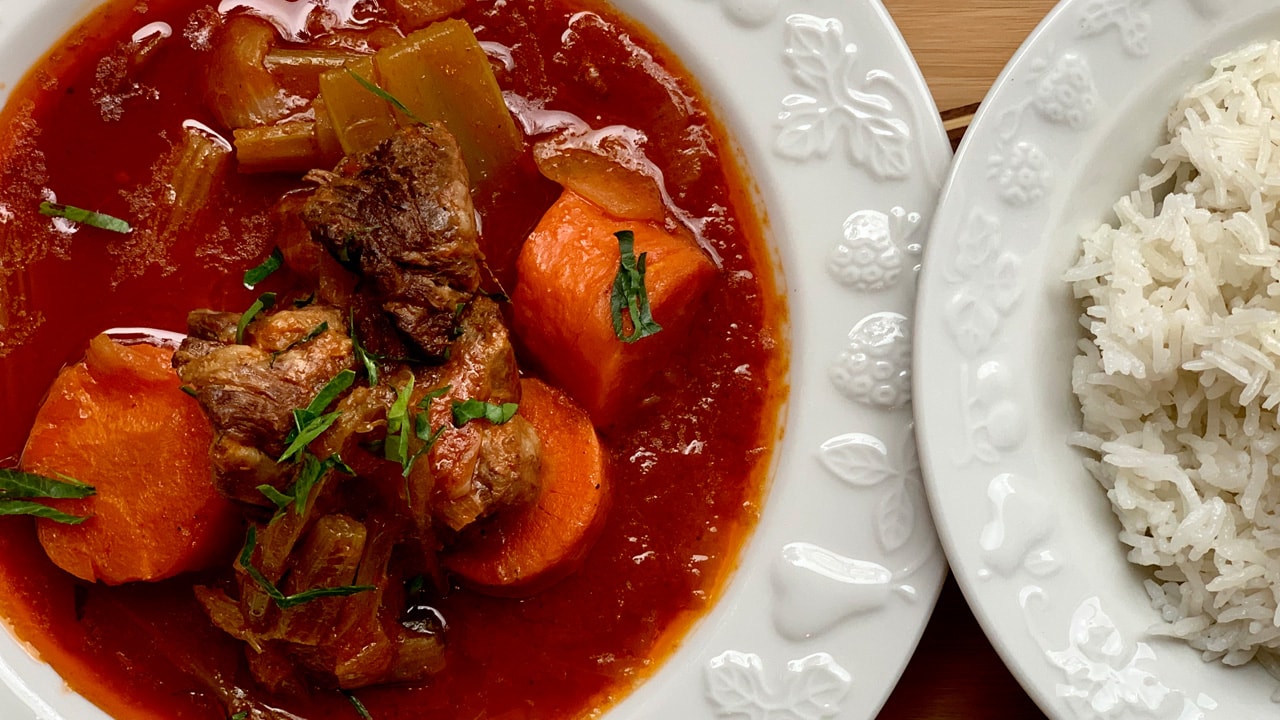
Lebanese Lamb Stew
- 2 ½ lbs. boneless leg of lamb, cut into 2-inch cubes
- 2 tsp. salt
- 1 tsp. black pepper
- 4 tbsp. olive oil, divided
- 6 cups beef stock
- 3 jumbo carrots, peeled and cut into 3-inch pieces
- 6 celery stalks, cut into 3-inch pieces
- 2 large yellow onions, peeled and cut into 3-inch cubes
- 1 ½ tbsp. coriander
- 1 ½ tbsp. cumin
- 2 tsp. aleppo pepper
- 1 tsp. cinnamon
- 1 ½ cups tomato purée
- Chopped mint (optional, for garnish)
In a large bowl, season the lamb generously with salt and pepper. In a large enameled cast-iron casserole pot, heat 2 tablespoons of olive oil until shimmering. Add half of the lamb cubes and cook over moderately high heat until browned, about 6 minutes; transfer to a plate. Brown the remaining lamb, adding 2 tablespoons of oil to the pot. Reduce the heat if the casserole bottom darkens too much. Return all of the lamb to the casserole and add the beef stock, carrots, celery, onions, spices and tomato purée, and bring to a boil, stirring to distribute the vegetables and dissolve the purée well with the stock. Turn down to a simmer and cook until the meat and vegetables are tender and the sauce is thickened and reduced, about 2 hours. Serve the stew in deep bowls. Garnish with mint. Serve with basmati rice.

Green Garlic Verde Pasta:
Ryley Eckersley,
Quaintrelle
Ryley Eckersley is a huge fan of rounding up whatever produce is fresh, available and in season, and using it to inspire his dishes at home and at work. He’s been doing that at Quaintrelle, the cozy eatery on North Mississippi Avenue, for over a year. As the restaurant temporarily shifts to takeout and delivery only, Eckersley is cherishing the time at home with his family, including two young sons.
They make biscuits and hash browns in the morning, veggie stir-fry and anything else he can think of to incorporate produce and dry goods from local purveyors. “We make bolognese in big batches, Central American-style red beans and rice, sloppy joes — it’s all definitely a good use of leftovers.” The London-born chef has cooked in restaurants in North Carolina, Barcelona, New York City and Central America before landing in Oregon from the U.K. in 2011.
If there’s one bit of advice he’d give to home cooks, it’s to keep buying veggies — both to stay healthy and to support local farmers. Most farmers markets allow customers to drive through and order their items, and local CSAs are also a great bet. Some of Eckersley’s favorites serving the Portland area are Wild Roots CSA, Your Kitchen Garden and Black Locust Farm; and fresh wheels of cheese through Cowbell Cheesemonger. For meat and other perishables, he says wholesale suppliers Nicky USA and Alexis Foods are offering great deals to the general public.
When buying veggies, Eckersley has his eye on spring and early summer produce like beets, potatoes, cabbage, broccoli, cauliflower, peas, asparagus and kohlrabi — as well as pantry items such as dried chiles and dried beans. All are perfect for making a ratatouille, bean or veggie stews, or a lovely slow-simmered ragu. He recommends pairing it with a fun and tasty dumpling pasta kids will have a blast making by hand. “Pick up your produce and base your week’s worth of meal ideas on that,” he says. “It’s not the end of the world — we still have veggies.”
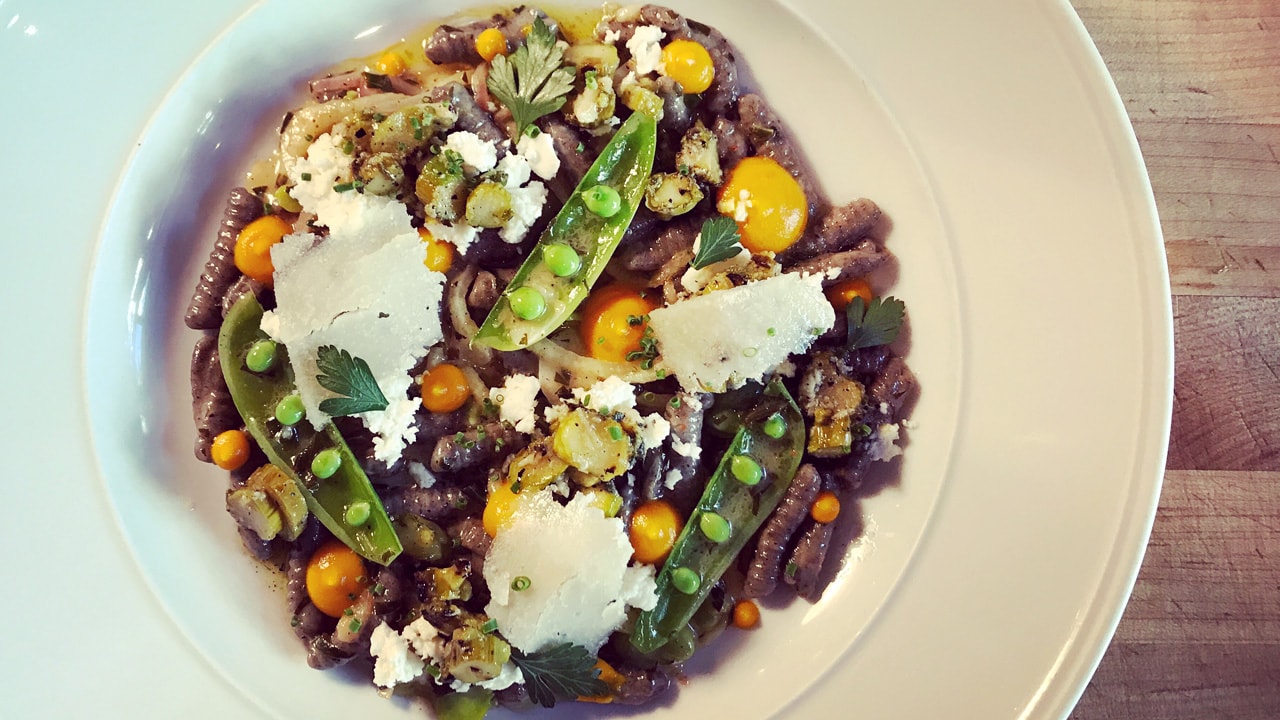
Green Garlic Verde Pasta
- 1 cup extra-virgin olive oil, plus more to cover if necessary
- 1 cup packed parsley leaves, finely chopped
- 1/2 cup packed mint leaves, finely chopped
- 1 sprig dill, finely chopped
- 1 bunch green onion, coarsely chopped
- 1 large bunch green garlic, finely chopped
- 1 tsp rosemary, finely chopped
- 1 cup Marcona almonds, coarsely chopped
- 2 tbsp. shallots, minced
- 1 tsp. lemon juice
- 1/2 tsp. lemon zest
- Spring brassicas (broccoli raab, kale, kohlrabi, cabbage, etc.) — a big bunch
Combine all ingredients except brassicas and toss well. Grab brassicas, season generously and grill to blacken a bit. Then chop them small (a bit bigger than the herbs, more like the size of nuts). Serve over your favorite artisan pasta such as cavatelli or gnocchi (store-bought, or experiment with your own). It makes a nice packed quart and is great to have on hand for everything!
